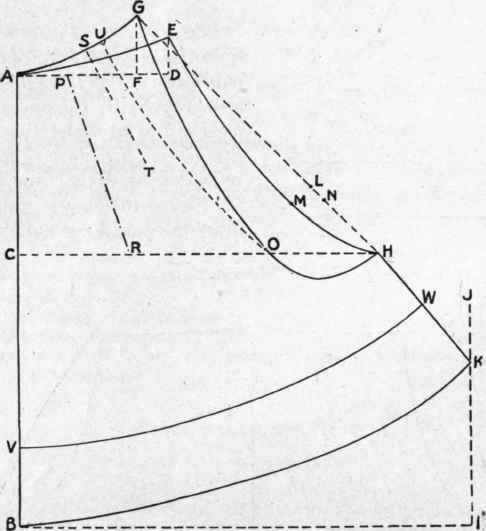To Draft Drawers
Description
This section is from the book "Clothing For Women: Selection, Design, Construction", by Laura I. Baldt. Also available from Amazon: Clothing For Women: Selection, Design, Construction.
To Draft Drawers
Fold paper lengthwise AB equals length to bend of knee.
AG equals one-half AB minus two and one-half inches. AD equals one-quarter waist measure plus two inches.

Fig. 62. - Draft of pattern for circular drawers.
DE equals one-twelfth waist measure.
AF equals one-quarter waist measure plus one-half inch.
FG equals one-eighth waist measure.
CH equals one-half hip measure plus one-half inch.
BI equals waist measure.
IJ equals line of indefinite length at right angles to BI. HK equals seven and one-half inches (use H asa pivot to swing line, K touching IJ). OH equals dotted line. LH equals five inches.
LM equals one and one-half inches (M at right angle to L). EMH equals curve for front.
HN equals four inches.
NO equals four inches (0 at right angles to N). GOH equals curve for back.
BK equals curve for lower edge of drawers.
AP equals two and three-quarter inches.
CR equals six inches.
Pr Equals Line -
. - . (line of direction for placing on the lengthwise thread of the material).
GS equals three and one-half inches.
Inverted Plait in Back
St Equals Ruler At Right Angles To Ag, Draw Line -
. - . for fold of plait which is laid to center back of drawers.
Habit Back
GU equals two and one-half inches. UO equals curve for habit back.
BV equals depth of ruffle minus seam. KW equals depth of ruffle minus seam. VW equals parallel to BK, line upon which pattern should be folded before cutting drawers from material, if a ruffle is to be used for trimming.
Suggestive Questions
1. Of what importance is the hip line in a skirt pattern?
2. State a general rule for designing gored skirts on a circular foundation.
Is there a limit to the number of gores? Show, by drawing, how to divide a circular foundation skirt into six gores.
3. Why should you test a skirt pattern in cambric before cutting in cloth?
4. What measures are necessary to draft a skirt pattern?
5. State several rules for fitting skirts.
6. Can a kimono night-gown be cut without a pattern?
7. What is the difference between straight and circular drawers?
8. If a drawers pattern is drafted to the finished length, and you wish to add a ruffle to this, what change is necessary in the pattern before cutting material?
References
Pattern Making
Fales, Jane. In preparation. Scribner, N. Y.
Gingles, Drafting.
Homer, J., Principles of Pattern Making.
Reeve, Amy J., Elements of Dress Pattern Making. London, 1912.
Reeve, Amy J., French Pattern Modelling. London, 1912.
Reeve, Amy J., Practical Dress Cutting. London, 1912.
Continue to:


